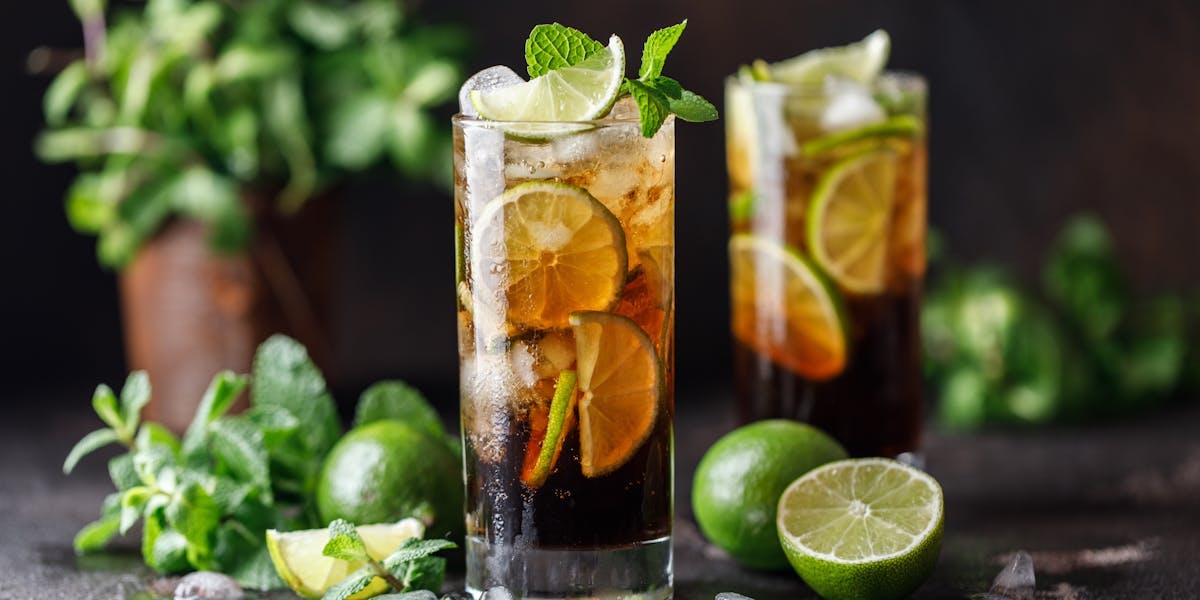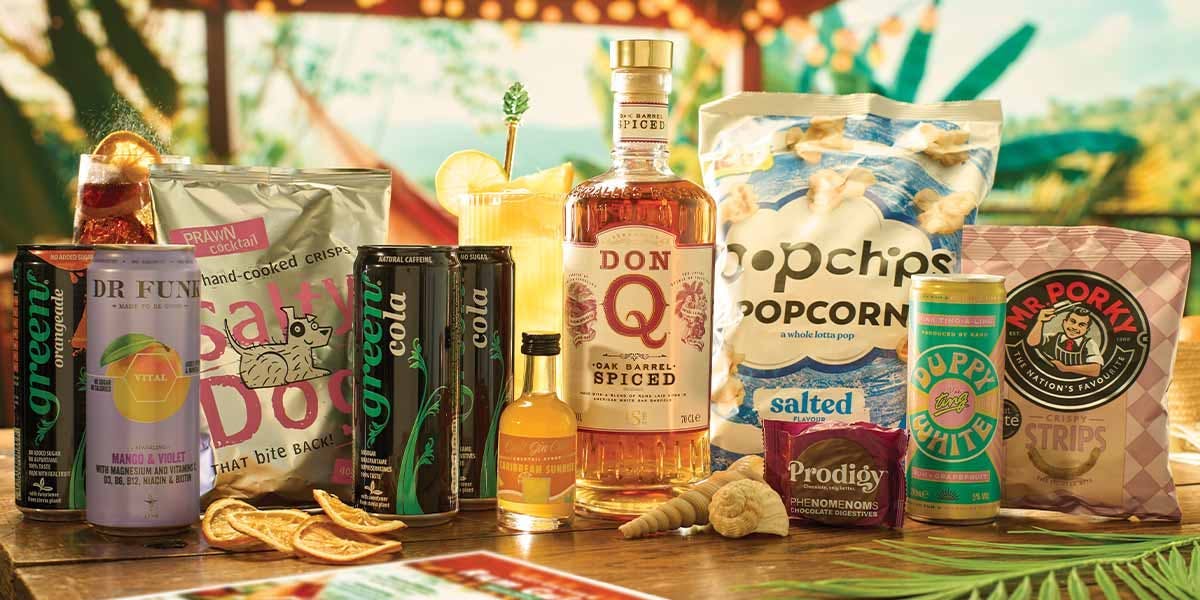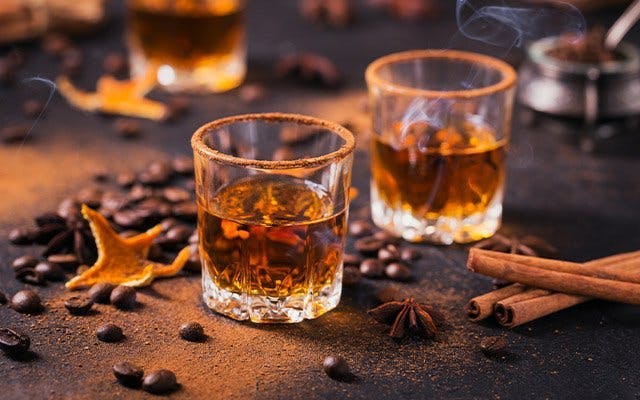Total flexibility, no commitment
A world of unique, crafted spirits
Easy, free and reliable delivery

Discover everything you need to know about whisky and whiskey!
To celebrate World Whisky Day (May 18th!) and the Whisky Special Selection tasting pack we have curated with the whisky wizards at Whisky Magazine, we are taking a look at whisky and whiskey (what's in a name?) to find out just what makes this fantastic spirit so special.
Whisky Special Selection tasting pack, you say?
Yes! This fantastic pack contains five fabulous miniature bottles of Scotch whisky specially selected for their remarkable quality and flavour. You can find out more about them below.
That’s right, we have mastered gin - you can find our guide to gin here. We have had a good go at rum - find our guide to rum here. Now it’s time to turn our attention to whisk(e)y too.
If you are new to whisky or simply wanting to discover more about this centuries-old spirit, then this is the place for you.
Scroll down to delve into our beginner’s guide to whisk(e)y. You’ll find everything you need to know, from how and where whisky originated to the difference between whiskey and whisky (the answer may surprise you) and, of course, this feature teaches you how to taste and drink whiskey too.
Let’s start with the very basics…
Is it spelt whiskey or whisky?
Whether it is spelt whiskey or whisky entirely depends on what part of the world the spirit comes from. Both refer to grain-based spirits.
Grain spirits from Scotland, Canada or Japan are spelt ‘whisky’.
Grain spirits from Ireland and the United States of America are spelt ‘whiskey’.

The differences began in the late 19th Century, when Irish distillers wanted to differentiate their product from Scotland’s, which, at the time, was seen as an inferior spirit.
It is thought that the USA then adopted the Irish spelling due to the amount of Irish immigrants that travelled there and the Japanese adopted the Scottish spelling because that is where key figures in the Japanese whisky movement honed their craft.
Fun fact: The word ‘whiskey’ is thought to have originated from the Gaelic term ‘uisce beatha’ which directly translates to ‘water of life’.
What is the difference between whiskey and whisky?
The only difference between whiskey and whisky is the spelling. Both whiskey and whisky refer to exactly the same product.

Whether you use whiskey or whisky, the term refers to a spirit made using a fermented mash of grains and then aged in wooden barrels - traditionally made from oak.
Different brands of whisk(e)y then differentiate themselves by using different grains like rye and corn, different ingredients like peat, and by ageing the spirit for different amounts of time in barrels made with different woods.
When and where did whiskey originate?
It is thought that monks in Ireland first fermented barley into what we now know as whiskey in the 11th Century.
Whiskey soon spread to Scotland as there was a lot of travel between the two countries at the time.

How is whiskey made?
Whiskey is made in six key steps: malting, mashing, fermentation, distillation, maturation and bottling.
Malting:
The point of malting and mashing (see below) is to make it easier for distillers to extract as much flavour from the grain as possible.
Malting is a process in which grains, most commonly barley, are soaked in water and allowed to germinate before being dried in a kiln.
If the distiller wants a smokier finish to their whiskey they may smoke the grains at this point too. Scotch whisky producer often burn peat at this stage to give their spirit that iconic peat flavour.

For some distilleries, like Lochlea Distillery in Scotland, the whisk(e)y-making process starts before the malting process because they grow their own barley.
By growing their own grain, they can ensure that the quality is controlled throughout the whole process.

Mashing:
In the mashing process, sugars from the grains are released, ready for the fermentation process.
Mashing involves grinding the dried grains into a meal known as ‘grist’. The grist is mixed with water to form a ‘mash’.
The mash is then raked constantly by machines or by hand. This process encourages enzymes to convert the starches in the grain into sugars ready for fermentation. The liquid produced by the mashing process is known as ‘wort’.

Fermentation:
During the fermentation process, the wort is mixed with yeast, which converts the sugars in the wort to alcohol. This process can take between two and four days.
Distillers can affect the flavour profile of their whiskey at this stage by choosing specific strains of yeast.
At the end of the fermentation process, the liquid will have an ABV (alcohol by volume) percentage of around 7 to 10%. This liquid is known as the ‘wash’.

Distillation:
The purpose of the distillation process is to remove any impurities from the wash and increase its alcohol content.
The distillation process involves heating the wash through a ‘wash still’ and a ‘spirit still’ - both are usually made from copper, which helps to remove any bad tastes or smells from the liquid.
Most distillers distil their liquid two or three times. This leaves them with a high-quality end product.

Maturation:
The maturation process is where the whiskey takes on a lot of its colour and flavour.
The maturation process involves ageing the spirit produced by the distilling process in wooden barrels, often referred to as ‘casks’.
Most casks are made from oak but this is not a requirement and distillers do experiment with other woods.
One such distillery is Scotland’s Wolfburn Distillery. Their Aurora edition whisky is aged in American oak barrels and casks that once held Spanish Oloroso sherry. The result is a stunning whisky with fruitier tones.
Whatever wood is used, the spirit is left in these casks to mature into the finished whiskey product.
Scotch whisky is required to be matured for at least three years for it to be labelled Scotch.
American whiskey is only required to be matured for two years.
Most distilleries age their whiskeys for much longer though and they often charge a premium for their longest-aged whiskeys.

Bottling:
Bottling is the final stage of the whiskey-making process and it can only be done when the whiskey is at least 40% ABV.
Many distillers spend a lot of time choosing the right bottle for their whiskey to help it stand out from the crowd and express their brand ideals.

Can whiskey go bad?
An unopened bottle of whiskey will not go bad provided it is stored in a cool, dark place away from direct sunlight.
Once the bottle of whiskey is opened, the liquid may lose some of its flavour over time however it will not expire or ‘go bad’. This is because the alcohol content is so high.
We recommend drinking an opened bottle of whiskey within six months in order to enjoy it at its best.
Will whiskey freeze?
Whiskey will not freeze in a conventional freezer.
Whiskey will freeze at around -27C. Most conventional freezers can only go as low as -18C.
What are the different types of whiskey?
Irish whiskey
As you may have guessed, Irish whiskey must be made in Ireland.
It can come in single-malt whiskey, grain whiskey, single-pot still whiskey and blended whiskey forms (see below for definitions of these whiskey variations).
You can expect Irish whiskeys to be smooth and rich on the palate, with a golden colour and none of the smokiness you might expect from Scotch (although there are exceptions).
A great example of Irish whiskey is Jameson Whiskey, which is distilled at the New Midleton Distillery in Cork. But the multi-award-winning Glendalough Irish Whiskey is worth a try too!

Rye whiskey
Rye whiskey is one of the first American whiskeys. It began being distilled when European settlers to America discovered that rye was one of the main grains to grow in the area they settled.
The spirit must be made with at least 51% rye grain and be mixed with nothing but water to be labelled Rye whiskey. It is traditionally matured for at least two years in charred new oak barrels.
Rye whiskey has a flavour profile that is crisp, with hints of spice.
Sazerac Rye is a great rye whiskey to start with if you have never tried the spirit before and once you have tried that, you simply must give Arbikie Highlander Rye Single Grain Scotch Whisky a go too. This Scottish rye whisky is not to be missed!

Bourbon whiskey
Bourbon whiskey, or simply ‘Bourbon’, is perhaps the most famed type of whiskey. To be labelled ‘Bourbon’ the spirit must be made with at least 51% corn grain and have only water added.
Bourbon must also be made in America, and it is most often distilled in the southern states although this is not a requirement.
And that’s not all. To get the full Bourbon seal of approval, the whiskey must be matured in charred new oak barrels for at least two years.
Bourbon traditionally has a mix of woody and sweet tones that make it one of the easiest whiskeys to enjoy for newcomers.
Eagle Rare, Makers Mark and Woodford Reserve are all great Bourbons to start off with.

Tennessee Sour Mash whiskey
Tennessee Sour Mash Whiskey, also known as Tennessee Bourbon, is a variation of Bourbon whiskey that is made exclusively in Tennessee.
Tennessee Bourbon must be made from between 51 and 79% corn grain, and the spirit must be filtered through maple charcoal chunks before the maturation process.
The most famous example of Tennessee Whiskey is Jack Daniels.

What are the different types of whisky?
Scottish whisky
Also simply known as ‘Scotch’, Scotch whisky must be made in Scotland to be labelled as such.
Much like Irish whiskey, Scotch can come in single-malt whisky, grain whisky and blended whiskey forms. Scotch whiskies are predominantly made with barley, however, other grains like corn and wheat can also be used.
Scotch is often recognisable for its ‘peaty’ flavour profile. This comes from the unique practice of burning peat to roast the grains during the malting process.
Prime examples of Scotch whisky are Laphroaig 10 Years Old and Lagavulin 16 Years Old. But one of our favourites has to be Torabhaig Allt Gleann Batch Strength Scotch Whisky. This single malt whisky has a higher strength of alcohol and a wonderful mix of fruity and peaty tones.

Japanese whisky
Japanese whisky was inspired by Scotch and is made using identical distilling methods, the only difference being that Japanese whisky is made in Japan.
Even so, Japanese whisky distillers are slowly caving out a niche for themselves and are held in very high regard. Yamazaki Single Malt Sherry Cask 2013 is even considered by many to be the best whisky in the world. With a price tag of £8000.00 a bottle, however, you may want to start with something a little more down to earth.
Yamazaki 12-Year-Old is a much more reasonable example of Japanese whisky to start with.

Canadian Whisky
Canadian whisky production boomed during the American prohibition era and it is still strong today. Canadian distilleries mostly use rye grain and corn but the rules governing Canadian whisky production are pretty vague.
The whiskey must be produced in Canada and it must be matured in wooden casks for three years, at least. It must also have the flavour profile traditionally associated with Canadian whisky, although that flavour profile is not clearly defined.
The flavour profile of Canadian whisky is usually lighter and sweeter than other whiskeys, making it very easy to drink and a great starter for those just entering the world of whisky.
Fun fact: While producing their whisky, many Canadian distillers produce two whiskies and then combine them. One is a ‘base whisky’ and the other is a ‘flavouring whisky’.

More whiskey definitions:
When talking about Irish and Scotch whisk(e)y above, we mentioned the subcategories of whisk(e)y called single-malt, grain, single-pot still, and blended whisk(e)y.
What do they mean? Let’s find out…
Single-malt
Single-malt whiskeys are whiskeys that have been distilled using only barley grain. They can only be distilled at a single distillery in small pot-stills, and the liquid must be distilled at least twice.
Single-malt whiskeys must also be aged for a minimum of three years in oak casks.
Nc’Nean Organic Single Malt Scotch Whisky is a beautiful example of the singe-malt style, with its exceptionally smooth and complex palate.

Grain whiskey
Grain whiskeys are whiskeys made with grains other than barley. The alternative grains are normally corn or wheat.

Blended whiskey
Blended whiskey refers to a whiskey that has been created by combining two different whiskeys, be that whiskeys from different distilleries or from the same distillery but the whiskeys are made with different grains.

Single-pot still whiskey
Single-pot still whiskey is unique to Ireland and it involves making whiskey with both malted and unmalted barley grains.

How do you drink whiskey?
Whiskey can be enjoyed in many different ways, including in lots of delicious cocktails. You can find our list of the best classic whiskey cocktail recipes here.
If you are new to whiskey or simply want to get a real and pure sense of what whiskey tastes like, then we recommend trying whiskey neat.
How to taste whiskey:
Much like gin, there are three parts to tasting whiskey: the nose, the palate and the finish. Through these three parts, you can experience the full range of flavours a whiskey may offer.
The nose:
Start by pouring a measure into a tasting glass or rocks glass. Then bring your nose to the top of the glass and breathe in with your mouth open to get a sense of the whiskey’s aromas.
You can wake up more of the aromas by placing your hand over the top of the glass and swirling the whiskey. Remove your hand, take a long, deep breath in and see what flavours reveal themselves.
Now you are ready for your first sip…

The palate:
The palate is about more than simply the taste of the whiskey, the palate is about texture too. Does the whiskey feel watery in your mouth? Does it have more of a syrupy texture?
Take your first sip and allow the liquid to coat your entire tongue, the inside of your cheeks and all around your gums.
What flavours do you get across your tongue? Is the liquid numbing? Is it silky smooth? These are all details to consider in the palate stage of whiskey tasting.
The finish:
This is where you swallow the whiskey and make a note of the sensations and flavours that develop when you do.
Consider: Does the whiskey burn as you swallow it? Is there a spicy sensation? Do any new flavours come through after you have swallowed the whiskey? How long do the whiskey flavours last in your mouth?
All that is left to do then is consider the experience and flavour profile of the whiskey as a whole. Was the whiskey sweet or peaty? Was the whiskey thin or viscus? Did it have a long finish? Did it make you want to take another sip?
We recommend taking another sip of the whiskey with a drop of water added after that initial neat tasting and making a note of any changes that occur.

Why do you add water to whiskey?
Adding a couple of drops of water to whiskey opens up more of its bouquet and releases new flavours within the spirit.
Start with around half a teaspoon of water in a single measure of whiskey and see how that changes the flavour profile. You may be surprised how much it does!
















